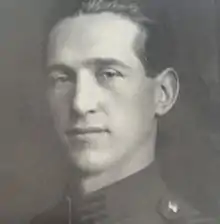David Neligan
David Neligan (1899–1983), known by his soubriquet "The Spy in the Castle", was a crucial figure involved in the Irish War of Independence (1919–21) and subsequently became Director of Intelligence for the Irish Army after the Irish Civil War (1922–23).

Early life
David Neligan was born at Templeglantine, Limerick where his parents, David and Elizabeth Neligan, were primary school teachers. He was an accomplished hurler with his local Templeglantine GAA Club.
Against his father's wishes, Neligan joined the Dublin Metropolitan Police (DMP) in 1917. Picking up travel documentation from the local Royal Irish Constabulary barracks he declined a suggestion that he enlist in this armed rural force. After service as a uniformed constable with the DMP, Neligan transferred into the plain-clothed detective and intelligence branch G Division in 1919. In May 1920 Neligan's elder brother Maurice (1895–1920), an Irish Republican Army (IRA) member and friend of Michael Collins, persuaded him to resign from the DMP.
After his resignation Neligan returned to his native County Limerick. Shortly afterward his brother Maurice was killed in a motorcycle accident, near their home in Templeglantine. In the meantime Neligan received word from a family friend that Michael Collins wished to meet with him in Dublin. Collins persuaded Neligan to rejoin the DMP and provide information to the IRA. Along with Eamon Broy and James McNamara, he acted as a valuable agent for Collins and passed on reams of vital information.
In 1921 Collins ordered Neligan to let himself be recruited into MI5. He used this as an opportunity to memorise their passwords and the identities of their agents. All of this was passed on to Collins. After Broy and McNamara were dismissed in 1921, Neligan became Collins' most important mole in Dublin Castle.
Irish Civil War
On the outbreak of the Civil War in June 1922, Neligan joined the National Army in Islandbridge Barracks with the rank of Commandant, and was attached to the Dublin Guard. He was involved in the seaborne assault on Fenit and spent the remainder of the war serving as a local intelligence officer operating between Ballymullen Barracks Tralee & Killarney. He has been accused of involvement in several atrocities including the Ballyseedy Massacre. However, Ernie O'Malley expressed doubts as to the evidence of this. In 1923 Neligan was posted to Dublin, where he was promoted to Colonel and succeeded Diarmuid O'Hegarty as National Army Director of Intelligence.
Later life
In 1924 Neligan handed over his post to the youthful Colonel Michael Joe Costello and took command of the DMP (which still continued as a force separate from the newly established Garda Síochána) with the rank of Chief Superintendent. The next year he transferred to the Garda when the two police forces were amalgamated, and was instrumental in the foundation of Garda Special Branch. When Éamon de Valera became head of government in 1932, his Republican followers demanded Neligan's dismissal. He was subsequently transferred to an equivalent post in the Civil Service.
Neligan drew pensions from the DMP, the British MI5, the Garda Síochána and the Irish Civil Service. He also received an 'Old IRA' pension through the Department of Defence.[1]
References
- Coogan, Tim Pat (2002). Michael Collins: The Man Who Made Ireland. Palgrave Macmillan. p. 76. ISBN 978-0-312-29511-0. Retrieved 2010-07-07.
Sources
- The Spy in the Castle by David Neligan.
- Who's Who in the Irish War of Independence 1916-1921. Padraic O'Farrell, Mercier Press 1980.